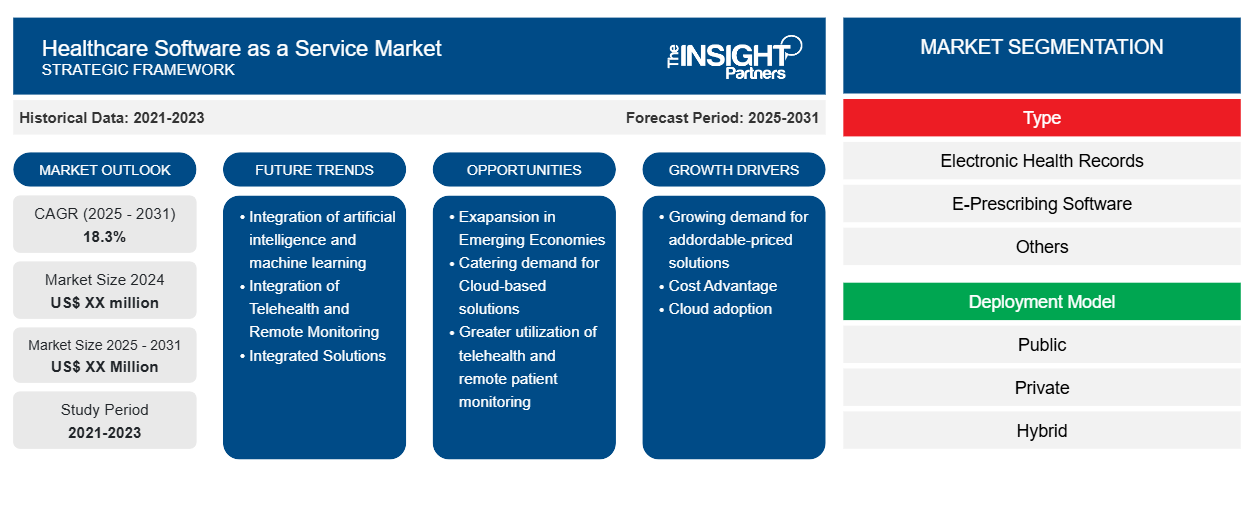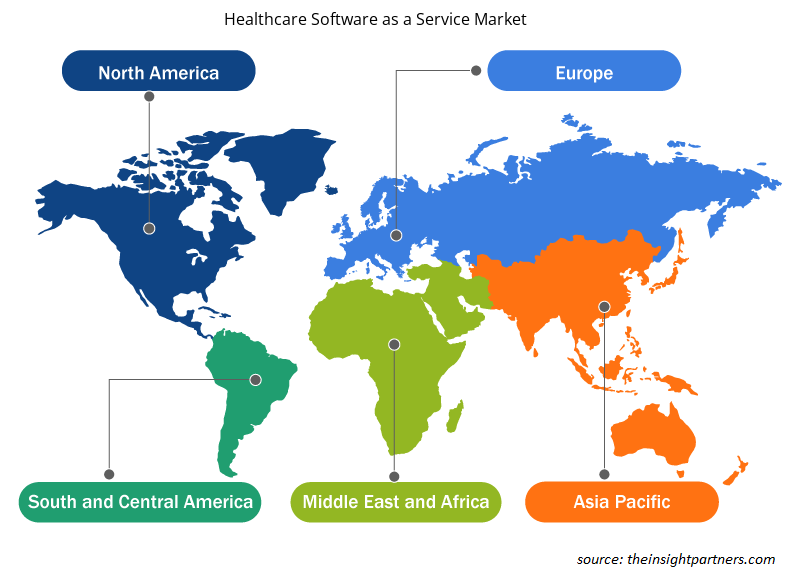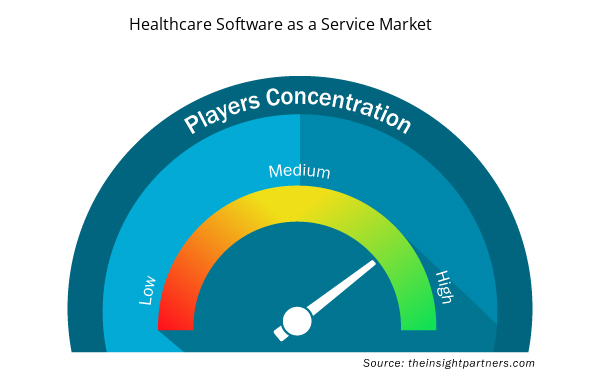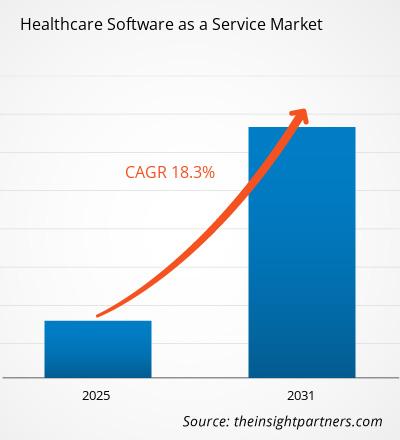The Healthcare Software as a Service Market is expected to register a CAGR of 18.3% from 2025 to 2031, with a market size expanding from US$ XX million in 2024 to US$ XX Million by 2031.
The Healthcare Software as a Service (SaaS) Market report provides an in-depth analysis segmented by service type, deployment model, end user and geography. It includes a regional breakdown, highlighting key markets and countries to present a comprehensive global perspective. Market evaluations are expressed in US dollars (US$), offering insights into market dynamics, growth trends, and competitive landscapes across various regions. This analysis empowers stakeholders to identify potential opportunities and make informed decisions in the rapidly evolving healthcare SaaS landscape.
Purpose of the Report
The report Healthcare Software as a Service Market by The Insight Partners aims to describe the present landscape and future growth, top driving factors, challenges, and opportunities. This will provide insights to various business stakeholders, such as:
- Technology Providers/Manufacturers: To understand the evolving market dynamics and know the potential growth opportunities, enabling them to make informed strategic decisions.
- Investors: To conduct a comprehensive trend analysis regarding the market growth rate, market financial projections, and opportunities that exist across the value chain.
- Regulatory bodies: To regulate policies and police activities in the market with the aim of minimizing abuse, preserving investor trust and confidence, and upholding the integrity and stability of the market.
Healthcare Software as a Service Market Segmentation
Type
- Electronic Health Records
- E-Prescribing Software
- Others
Deployment Model
- Public
- Private
- Hybrid
End User
- Healthcare Providers
- Healthcare Payers
Geography
- North America
- Europe
- Asia-Pacific
- South and Central America
- Middle East and Africa
Customize This Report To Suit Your Requirement
You will get customization on any report - free of charge - including parts of this report, or country-level analysis, Excel Data pack, as well as avail great offers and discounts for start-ups & universities
Healthcare Software as a Service Market: Strategic Insights

- Get Top Key Market Trends of this report.This FREE sample will include data analysis, ranging from market trends to estimates and forecasts.
Healthcare Software as a Service Market Growth Drivers
- Growing demand for addordable-priced solutions: Of course, one of the very key factors amongst them is the ever-growing demand for affordable-priced solutions for healthcare IT. In this respect, there is constant pressure on healthcare organizations to reduce operational costs while simultaneously improving patient outcomes.
- Cost Advantage:Traditional on-premise IT infrastructure requires significant investments upfront and regular upkeep costs. On the other hand, SaaS models offer subscription-based payment schedules that enable health organizations to tap advanced technologies without having to tie up massive capital funds. This level of affordability and scalability makes it a highly desired product, especially for the small and midsized health care provider who is getting access to very high-quality IT solutions that were previously out of reach.
- Cloud adoption: In itself, cloud computing has taken off, where health organizations have found themselves migrating from on-premise solutions to cloud-based services. SaaS platforms provide an important accessibility to data and software applications from any location, and such flexibility is critical for healthcare organizations operating in wide geographies or with access via remote locations. The COVID-19 pandemic accelerated this movement toward SaaS, as providers found the pressing need for cloud-enabled operations to facilitate workforces working from homes, telemedicine services, and other decentralized processes. The growing demand for cloud technologies in healthcare brings rapid growth to the SaaS market share, as organizations work at updating their IT infrastructures.
Healthcare Software as a Service Market Future Trends
- Integration of artificial intelligence and machine learning: Integration of AI and ML in form of healthcare software solutions most promising trend in this market. These software alter predictive analytics, clinical decision support, and personalized medicine. To investors, this means that those companies integrating AI-driven tools into their respective SaaS offerings will hold the biggest potential for growth. AI not only helps healthcare organizations improve their capability to predict patient outcomes but also optimizes clinical workflows. Moreover, it increases diagnosis accuracy highly valuable for both providers and payers. Incorporation of these technologies may improve the returns on investment.
- Integration of Telehealth and Remote Monitoring: Telehealth, turbocharged by the COVID-19 pandemic, is here to stay. SaaS platforms that extend support for telehealth and remote patient monitoring see unprecedented demand as healthcare organizations move to virtual care models.
- Integrated Solutions: Solution providers offering integrated telehealth solutions, comprising video conferencing, digital patient records, and diagnostics, among others, are expected to witness good growth during this period. It is also a very savvy move for investors to watch out closely for companies offering telehealth features or expanding platforms for virtual care, as this will be a Healthcare SaaS market trend that continues well into the future.
Healthcare Software as a Service Market Opportunities
- Exapansion in Emerging Economies: Some of the major Healthcare SaaS market opportunities are emerging markets such as Asia-Pacific, Latin America, and parts of Africa. In these regions, healthcare infrastructure is developing very fast, which is a result of the increased government spending and private investment.
- Catering demand for Cloud-based solutions: Demand for cloud-based healthcare solutions is increasing, especially in such regions, which find the establishment of legacy on-premise systems either too expensive or impossible. In this regard, SaaS providers offering affordable, scalable, and easily deployable solutions designed to fit the specific needs of these markets can gain considerable market share. This is where investors can look at companies that are already expanding into such highly underserved regions for long-term healthcare SaaS market growth.
- Greater utilization of telehealth and remote patient monitoring: Virtual care models, especially those sped up by the COVID-19 pandemic, have placed telehealth as a permanent fixture among many healthcare systems. And that, in turn, bolsters the demand for SaaS solutions with integrated telemedicine capabilities such as video consultations, digital patient records, and real-time diagnostics. Moreover, it also extends to various areas such as remote monitoring devices for chronic disease management and post-hospitalization care. Companies that have a complete SaaS platform offering, through which telehealth and RPM can be provided, are thus very well-placed to take advantage of this continued shift towards virtual care.
- Integration of AI and ML into healthcare SaaS platforms presents an opportunity for improvement in better care provision, operational efficiency, and predictive analytics. The identified key enablers for healthcare providers and payers will be AI-driven clinical decision support tools, predictive analytics, and workflow automation. Those SaaS companies now embedding AI within their platforms can build value-added solutions that improve patient outcomes, make administrative tasks more efficient, and drive down operational expenses. Such companies, focusing on AI-driven innovation, will be targeted by investors as this technology transforms healthcare delivery and opens new avenues for revenue generation.
Healthcare Software as a Service Market Regional Insights
The regional trends and factors influencing the Healthcare Software as a Service Market throughout the forecast period have been thoroughly explained by the analysts at Insight Partners. This section also discusses Healthcare Software as a Service Market segments and geography across North America, Europe, Asia Pacific, Middle East and Africa, and South and Central America.

- Get the Regional Specific Data for Healthcare Software as a Service Market
Healthcare Software as a Service Market Report Scope
| Report Attribute | Details |
|---|---|
| Market size in 2024 | US$ XX million |
| Market Size by 2031 | US$ XX Million |
| Global CAGR (2025 - 2031) | 18.3% |
| Historical Data | 2021-2023 |
| Forecast period | 2025-2031 |
| Segments Covered |
By Type
|
| Regions and Countries Covered | North America
|
| Market leaders and key company profiles |
Healthcare Software as a Service Market Players Density: Understanding Its Impact on Business Dynamics
The Healthcare Software as a Service Market market is growing rapidly, driven by increasing end-user demand due to factors such as evolving consumer preferences, technological advancements, and greater awareness of the product's benefits. As demand rises, businesses are expanding their offerings, innovating to meet consumer needs, and capitalizing on emerging trends, which further fuels market growth.
Market players density refers to the distribution of firms or companies operating within a particular market or industry. It indicates how many competitors (market players) are present in a given market space relative to its size or total market value.
Major Companies operating in the Healthcare Software as a Service Market are:
- NXGN Management, LLC
- Veradigm LLC
- AdvancedMD, Inc.
- Capterra Inc.
- Orchard Software Corporation
Disclaimer: The companies listed above are not ranked in any particular order.

- Get the Healthcare Software as a Service Market top key players overview
Key Selling Points
- Comprehensive Coverage: The report comprehensively covers the analysis of products, services, types, and end users of the Healthcare Software as a Service Market, providing a holistic landscape.
- Expert Analysis: The report is compiled based on the in-depth understanding of industry experts and analysts.
- Up-to-date Information: The report assures business relevance due to its coverage of recent information and data trends.
- Customization Options: This report can be customized to cater to specific client requirements and suit the business strategies aptly.
The research report on the Healthcare Software as a Service Market can, therefore, help spearhead the trail of decoding and understanding the industry scenario and growth prospects. Although there can be a few valid concerns, the overall benefits of this report tend to outweigh the disadvantages.
- Historical Analysis (2 Years), Base Year, Forecast (7 Years) with CAGR
- PEST and SWOT Analysis
- Market Size Value / Volume - Global, Regional, Country
- Industry and Competitive Landscape
- Excel Dataset



Report Coverage
Revenue forecast, Company Analysis, Industry landscape, Growth factors, and Trends

Segment Covered
This text is related
to segments covered.

Regional Scope
North America, Europe, Asia Pacific, Middle East & Africa, South & Central America

Country Scope
This text is related
to country scope.
Frequently Asked Questions
Some of the customization options available based on request are additional 3-5 company profiles and country-specific analysis of 3-5 countries of your choice. Customizations are to be requested/discussed before making final order confirmation, as our team would review the same and check the feasibility.
NXGN Management, LLC, Veradigm LLC, AdvancedMD, Inc., Capterra Inc., Orchard Software Corporation, Belitsoft, ResMed, POSTDICOM, Nalashaa, and CrelioHealth Inc. are a few prominent players operating in the healthcare software as a service market.
The market is expected to register a CAGR of 18.3% during 2023-2031
The Healthcare Software as a Service Market is driven by demand for affordable solutions, cloud adoption, and flexibility, enabling healthcare organizations to reduce costs while improving patient outcomes and accessibility.
Key trends in the Healthcare SaaS market include AI integration for predictive analytics and improved diagnostics, alongside increased demand for telehealth and remote monitoring solutions post-COVID-19.
The report can be delivered in PDF/PPT format; we can also share excel dataset based on the request.
Trends and growth analysis reports related to Technology, Media and Telecommunications : READ MORE..
- NXGN Management, LLC
- Veradigm LLC
- AdvancedMD, Inc.
- Capterra Inc.
- Orchard Software Corporation
- Belitsoft
- ResMed
- POSTDICOM
- Nalashaa
- CrelioHealth Inc.

 Get Free Sample For
Get Free Sample For